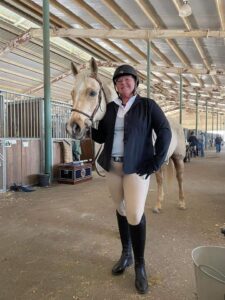Before you read on, make sure to check out Part 1 of Sarah’s story. In Part 1, Sarah discusses the traumatic (and life-threatening!) odyssey that led to her eventual Addison’s disease diagnosis in 2014. Today, we discuss how Sarah learned that she also had stiff person syndrome (SPS), what SPS is, and the challenges of living with dual conditions.
2022: Learning about Stiff Person Syndrome (SPS)
Over the years, Sarah came to terms with her Addison’s disease diagnosis and learned to manage it, though she did sometimes struggle with debilitating fatigue. Then, in 2022, worsening fatigue and lethargy, as well as unexplained muscle pain, brought her back to the doctor. Assuming that the symptoms were related to Addison’s disease, the doctor advised for an increase in hydrocortisone. But there was no symptom improvement even after a week or two. In fact, her pain levels spiked, and Sarah began having debilitating muscle spasms. Sarah was referred to a rheumatologist as her doctor believed that she could have lupus. The visit, however, ruled out any rheumatological concerns.
One of her greatest advocates throughout this process, as he was in her Addison’s disease diagnostic journey, has been Sarah’s endocrinologist. She describes him as a wealth of information who is always available, accessible, and able to help. As she searched for what might be happening, her doctor was at her side. She shares:
“My endocrinologist is brilliant and always thinks outside of the box. He mentioned that what I had might be myasthenia gravis or stiff person syndrome. I looked up both conditions and tried to figure out what was going on as his office worked to get me in with The Mayo Clinic or The Cleveland Clinic.”
Unfortunately, there was a hold-up with insurance. Soon, Sarah found herself largely unable to work. Her body felt stiff and painful; the muscle spasms that rippled through her body caused her to cry out in pain. Although she had an appointment with a neurologist, it was still months away. Her doctor suggested that Sarah be admitted to the hospital to be seen by the neurologist there. Between the hospital neurology appointment, conversations with Sarah’s doctor, and her medical records, the hospital quickly determined that Sarah had stiff person syndrome.
What is Stiff Person Syndrome (SPS)?
Stiff person syndrome (SPS) is a rare acquired neurological disorder that, as Sarah describes:
“Affects the muscles, especially through the back, neck, and trunk areas. It causes stiffness and rigidity to the point that moving can be difficult. There are so many variants of it. Some people have very mild symptoms while others have extremely severe symptoms. SPS can cause pain and spasms, weakness, extreme fatigue, and discomfort when hearing certain sounds or being touched.”
The exact cause of SPS is unknown, though doctors hypothesize that it could be some sort of autoimmune condition. This is because people with SPS often have high glutamic acid decarboxylase antibody levels. Treatment options for SPS typically focus on reducing symptoms. For example, patients may use benzodiazepines for muscle spasms or even anti-seizure medications. Sarah uses IVIG treatments.
The Challenges of Living with Two Rare Conditions
When it comes to living with two rare conditions, Sarah says:
“It’s certainly no picnic. Between Addison’s and SPS, the fatigue can be debilitating, and I have to take frequent breaks. Some days I’m unable to get out of bed at all. It is very hard to live a normal life. I’m trying to run a business and be able to keep teaching my riders. I have horses to take care of, not to mention my son! I get stared at in the store when I’m driving the little carts around. I can’t push a cart and grocery shop. I would be in bad shape if I tried. I don’t “look” sick, and I think people sometimes assume that I’m lazy. I just hope that others will understand that just because I am up and moving one day—teaching lessons, cooking dinner, going to school functions with my son—does not mean that I’m ‘ok.’ I cover the pain a lot. I do what I can when I can so that I still feel a little like myself.”

In sharing her story, Sarah hopes to amplify the idea that invisible illnesses can be just as impactful as “visible” ones. But she also hopes to stimulate change in the medical field. First, she hopes that stories such as hers will help drive research into why some rare conditions appear in tandem, or whether having one makes it more likely to have another. While she has several health conditions, her brother has none. Increased research could provide better answers to patients. Beyond this, Sarah also believes that sharing her story could help others—patients and doctors alike—become better versed in identifying a rare disease. She explains:
“Going through the diagnostic process for Addison’s disease was hell. I hope and pray that doctors listen to their patients more and help them seek answers. I hope that doctors will not feel so superior that they can’t admit that they don’t know what is happening and refuse to seek input from another doctor. I’ve been to so many ERs with adrenal crises where my husband has had to tell the doctor what Addison’s is and how to treat me for a crisis. We are over an hour away from my doctor and sometimes we need help urgently so we go to the closest ER. My husband has, multiple times, begged the ER doctor to call my endocrinologist and handed them his phone number, but they rarely consult with him. I just want doctors to be more aware of these conditions and what to look for.”
Sharing Advice
Finally, Sarah wants other people within the rare disease community to know that they are not alone in their struggles—and that they can be empowered to fight for a better life. She says:
“If you know something isn’t right, don’t let anybody blow you off. Keep searching until you find answers. Research your diagnosis. Join Facebook groups for those conditions, as they can be a huge resource to help you through things. Be your own advocate. And most of all, HANG IN THERE!”









